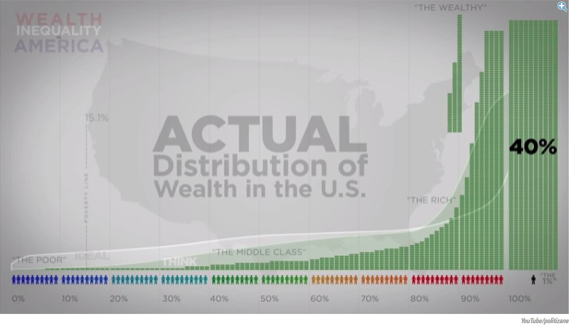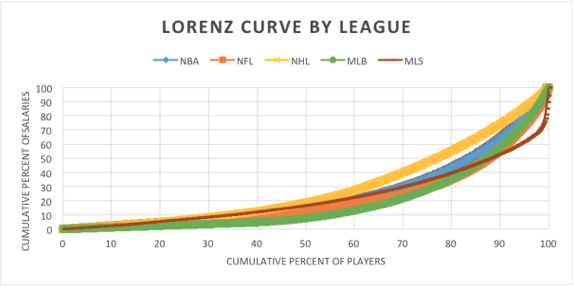Viewing society through the unique lens of the NBA By Mike Jagacki On February 14, 2016.
America loves sports. It’s a way to escape from reality, and yet root for the things we like most about it. There’s an ideal of parity; that handwork, passion and teamwork can overcome any obstacle. An alternative universe where poverty disappears. Corruption turns into competition. Inequality transforms into dreams.
But perhaps sports are affected by these cruelties; we just haven’t been looking in the right places.
The NBA for example is a place where after 5 years of retirement 60% of the players are broke, wrote Pablo Torre in How (and Why) Athletes Go Broke. Perhaps some of these players wasted their money on extravagant luxuries, unsound investments, and misplaced trust, but 60% is a high number to cast a blanket statement over. What if instead these athletes were caught in a corrupt system that reflected the economic inequality that exists in America?
Sports doesn’t escape reality, it reflects it. The average player in the NBA gets hit with high taxes, unequal retirement plans and a system corrupted by the top 1%. Thus the NBA offers a unique lens to view the economic inequality that plagues the nation today.
“According to the Census Bureau, the official Gini coefficient for the United States was 46.9 in 2010, the most recent year with data available,” (inequality.org).

The Gini coefficient was designed to measure wealth distribution between 0-100. So a Gini coefficient of zero means everyone makes the same amount of money. On the other hand, a Gini coefficient of 100 means all the wealth is in one person’s hand. Thus America’s 46.9 coefficient leaves it halfway between full equality and complete concentration. The numbers lean slightly towards full equality, but in reality 40% of the nation’s wealth is owned by the top 1%.
The Harvard Sports Analysis Department compared the salaries of professional athletes. The graphic demonstrates the same economic inequality that exists in America.

The Gini coefficient for NBA wages is actually 50.17: more severe than the income inequality in America.
Now it is hard to feel pity for a professional athletes who make a minimum salary of $500,000 a year, but that’s not the point. The point it to use sports as a unique lens to view society, so understand that the economic system that these athletes belong to, reflects the economic system prevalent in America. In some cases, their system is even worse.
Take the average player for example, he is not considered rich when his lifetime earnings are taken into account. “The median tenure in the league is roughly six years, but for someone who never becomes a starter (which is the vast majority of all NBA players), the median tenure is scarcely two years,” writes Ike Brannon, author of Income Inequality and the NBA. To call every player “rich” is misconstrued.
“There are many more players who hang onto an NBA roster playing for the minimum salary of $480,000 and hoping to stay in the league for a couple years, than there are players making eight figure salar yes.” Ike Brannon wrote.
These are the circumstances most American’s find themselves in today: working hard jobs to survive while the upper tier employees make incredible amounts of money. Not only is the minimum NBA player only earning 2% of the maximum player’s contract, but they are being taxed the same.
This is because tax brackets in the USA reach their apex around $400,000 of annual income. Therefore a person making $500,000 is taxed the same rate of income as someone making $20,000,000. At this level of income, those tax rates hover around 40-60% depending on the state. So the average NBA player losses half of his pay check to Uncle Sam.
This tax system deems these athletes as “rich” and therefore can rationalize taking 50% of their income. When in reality these athletes are not considered rich when “lifetime earnings are considered.” They have gone from making no money in college, to making thousands or millions of dollars in the NBA and then will go into retirement around the age of 30.
If they are lucky, they will have qualified for a pension; which requires a minimum of a 3-year career. This pension will pay them $56,000 a year at it’s minimum, but won’t be in affect until the age of 62, explains Mark Riddix, founder and president of New Horizons Financial Management.
The fact that nearly 60% of NBA players go broke within 5 years of retirement may not be the result of poor planning, but an economic system built upon inequality.
Thus far we have only treated player’s salaries as part of this system. When in fact there lies a 1% above the 1% athletes: the owners. In the latest collective bargaining agreement, in 2011, “the NBA forced players to give up “$270 million—an average of $610,000 per player—to team owners.” This was achieved by reducing the players’ share of basketball-related income from 57 percent down to a range of 49–51 percent,” The Century Foundation reported.
Half the money NBA players generate for their organization goes directly to their owners. On top of that, the owners set a ceiling for the maximum contracts. Which means, NBA superstars are actually worth much more than they are actually paid.
A corrupt system created and put in place by the 1% earners. Reflecting “the gap between worker pay and worker productivity that exists in the economy at large,” writes Imhotep Royster for Workers and Economic Inequality.
Yet the NBA is unionized; how did a player-represented entity accept such conditions?
“The compromise they offered—not explicitly but with a wink and a nod—was that the money superstars were unable to realize in salary could be made up in endorsements later. In fact, the league encouraged and helped to facilitate those deals,” writes Ramona Shelburne, ESPN senior writer.
The only Player’s Union who would accept such an agreement, would be a Union represented by the small percent of athletes who get offered an endorsement deal. Such individuals represent the NBA Player’s Union:
Union Position Name Salary
President Chris Paul 21.47 Million
First Vice President LeBron James 24 Million
Vice President Stephen Curry 11.37 Million
Where as a Union is suppose to protect the average worker, the NBA Player’s Union is represented by the top tier athletes. Devising a corrupt system collaborated by the 1% owners and the 1% players.
One such arrangement was made for the upcoming season. The start of a nine-year, $24 billion television deal is scheduled, and with it, an increase in the NBA salary cap of about $90 million. The maximum contracted player will see his income increase by about $6 million. The minimum contracted player will see his income increase by about $20,000.
Even in the NBA, the saying applies, the rich get richer and the poor get poorer. Of course this is subjective the salaries of NBA athletes. But this alternative universe acts as a microcosm for society.
Since the consequences of economic inequality are still unknown on a large scale, it has been hypothesized that one major drawback is corruption.
“When wealth distribution becomes concentrated in a small number of hands, political power tends to become skewed in favor of that small wealthy group. High-income groups are able and incentivized to manipulate government in their favor through both legal processes and through corrupt practices. Impoverished or working class groups are simultaneously less able to become educated or participate in the political process as economic means become increasingly scarce,” writes Nicholas Birdsong in The Consequences of Economic Inequality.
If the NBA is any representation, corruption is not only a result of economic inequality, but also the furthering of it. The 1% devises a system neglecting the needs and concerns of the average worker.
Sports are not an escape from reality; they are a reflection of it.

March 5, 2016 at 1:58 pm
Great article. I too was one of those who thought all…any NBA player was wealthy. Very enlightening.
LikeLike